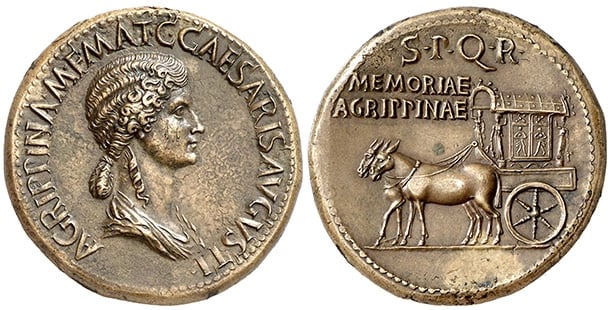La Giaconda the Mona Lisa of the First Century, from the Roman Empire.
 petitioncrown
Posts: 62 ✭✭✭
petitioncrown
Posts: 62 ✭✭✭
**Untouched ‘Masterpiece’ **

Orichalcum (Brass) Sestertius, struck in Rome 37-41. 28.82 g. die axis 6.00.
AGRIPPINA M F MAT C CAESARIS AVGVSTI This coin appeared on the cover of Giorgio Giacosa’s Women of the Caesars (1977) S P Q R / MEMORIAE / AGRIPPINAE rev. Carpentum drawn to the left by two mules; its roof is supported by standing figures at the corners, and the sides are ornamented.
Agrippina Senior is one of the most tragically unfortunate women of Roman history, in part because her pride was always an enemy of tact. This sestertius honoring Agrippina was minted by her son Caligula. The inscription, SPQR MEMORIAE AGRIPPINAE, tells us that the Senate and the Roman People dedicated it Agrippina’s memory.
This is a coin of both incredible detail and superlative condition: everything is clear, from the ring holding the reins of the donkeys to a portrait that launched my desire, my love, to acquire the coin. Very few coins of this period exist in such pristine natural condition.
Coins are Works of Art in just the same ways as paintings and sculpture can be: they all share the same qualities. Da Vinci’s painting of La Giaconda (Lisa del Giaconda, born Lisa di Antonmaria Gherardini, 1479-1542), known worldwide as the Mona Lisa, is here compared with a coin by an unknown master, which bears a portrait of no less importance: that of Agrippina, daughter of Agrippa and Julia, wife of Germanicus, and mother of Caligula.
Even though this portrait was struck in the first century after Christ, its beauty and feeling seems timeless. Without doubt the finest known specimen.
Suddenly it felt as if a hot lump of metal had landed in my stomach! , when first seeing this specimen. It was the beginning of a profound and intense love affair, which came like a bolt from the blue.
A coin that had survived in such a condition had to have a secret past: It was a Moretti coin who lived between Lugano in Switzerland and Milan Italy. Giacosa wrote the book called Women Caesars and these coins came from Moretti collection. This specific coin remained in such amazing condition as it was a Tiber coin. When found lodged in a lump of clay to be found in 1936 the years just prior to WW II? At some point this remarkable coin came into the hands of Athos Moretti an Italian-Swiss businessman, who was a passionate collector. It was later sold at Sotheby’s in 1995 (in the collection of yet another profound connoisseur, Ladislaus von Hoffmann). And today I am the lucky keeper.
Everyone has his or her own opinion of what a masterpiece is. I think it is when an artist attains a state detached from reality, when it his inner spirit, rather than his brain, that guides his hand, that he can create a piece of art that will last for time immemorial. Da Vinci’s Mona Lisa and Michelangelo’s David are such wonders.
The artist engraver who created the dies that were used to strike this coin, for, after all, Sestertii were used by the ordinary people of Rome, he created the Emperor Caligula a piece that would be treasured throughout the ages. This portrait of the adored and aristocratic mother of an emperor. and appears on a coin of ageless beauty. I have the honour to be its temporary custodian – may it be preserved for thousands of years more for future generations to enjoy.
The Worlds Most Prestigious and Valuable Silver Coin. Thomas Simon and two Kings of Numismatics together Petition Crown & 1804 $
Comments
Great coin and commentary. Thank you for sharing it with us.
That is so cool it almost hurts.
Really lovely engraving on that.
World Collection
British Collection
German States Collection
An amazing work of numismatic art.
If only the US Mint could do as well as the ancients.